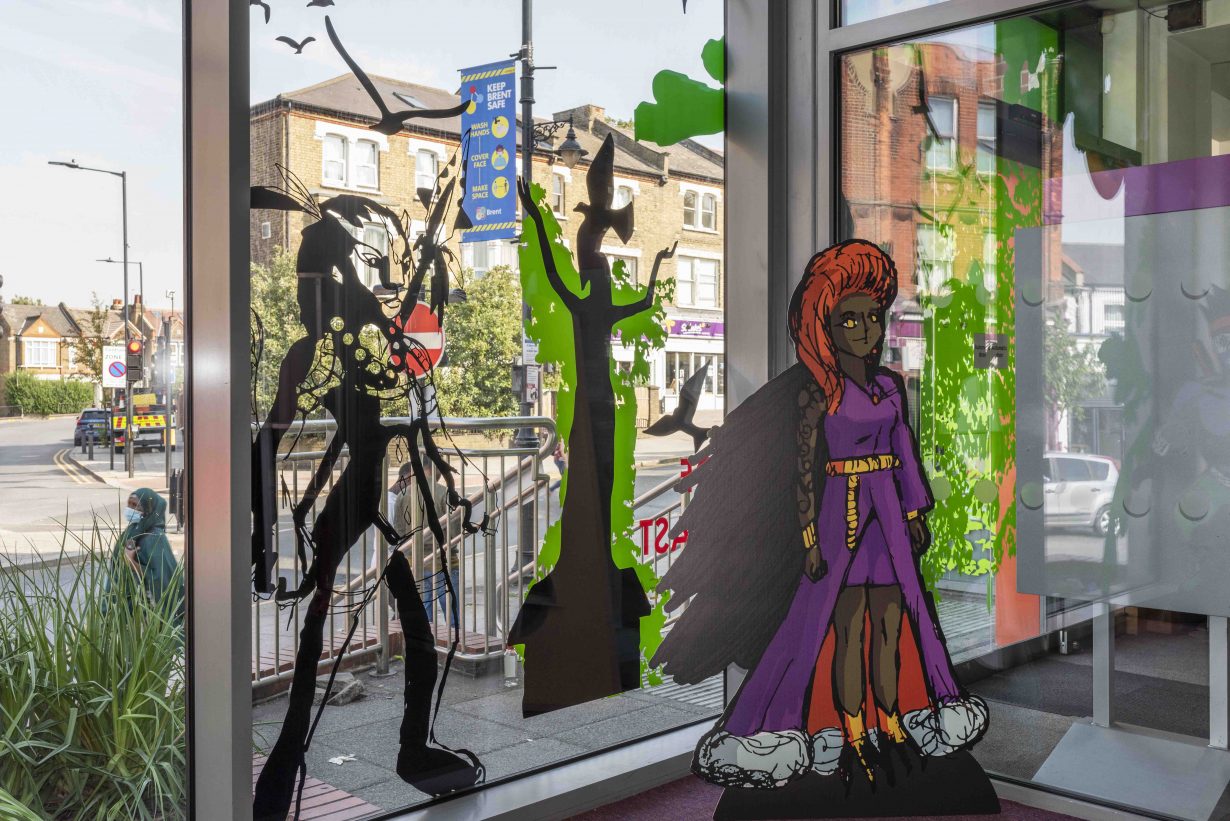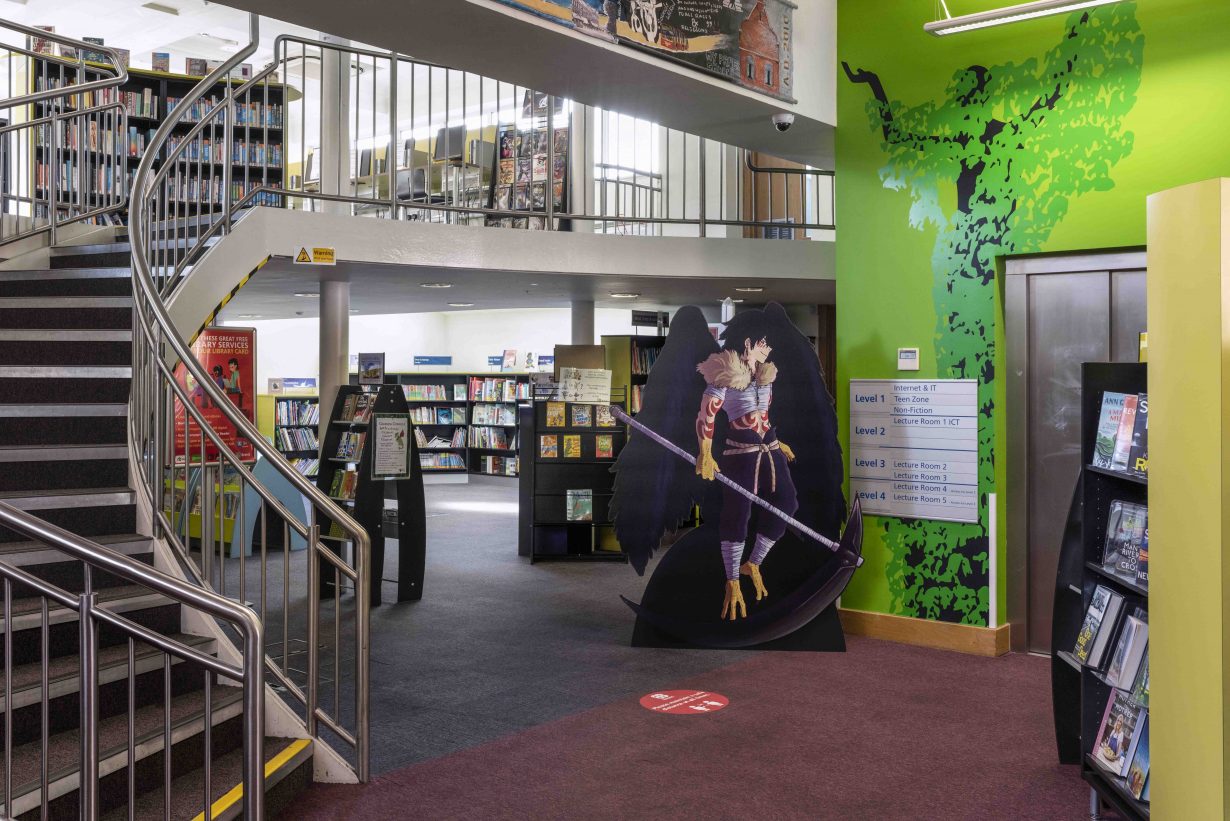David Blandy, for the Brent Biennial, imagines Harlesden 8,000 years in the future
Working in performance and moving image, David Blandy’s artworks and projects have for two decades explored the cultural forces that inform identity and kinship, ranging computer games and manga to hip hop and soul music. Though his influences are popular, the subject matter of his work is serious, taking in subjects like gender, race and the environment.
ArtReview Can you tell us about your project for the biennial?
David Blandy World After: Visions of the Deep Past is an expansion of a fantasy future world that I’ve been developing for the past two years, as tabletop role play game, film and fiction, site-specific for Harlesden Library. With young people from the local Roundwood Youth Centre and Capital City Academy we imagined what Harlesden would be like in 8000 years, after the sea has risen high enough that there is a shore at Kensal Green and all trace of humanity is lost to the great forests. We also imagined a series of societies that had evolved in local Havens, huge silos deep underground, and came up with four distinct Harlesden post-human evolutions. There are the avian Avari, who have a strict hierarchical society where rank is defined by plumage; the Torads, an amphibian feudal society in constant revolt; the Clawsa, an industrial matriarchal democracy where the ursine, feline and canine factions vie for supremacy; and the Underealms, a brutal anarchic society that revolves around scavenged technological body enhancement.
Harlesden Library has become a setting for this imagining, with coloured vinyl being used to cover the walls of the library in vines and to show dioramas from this world. Alongside that are cut-out standup figures, as you’d find in a cinema or gaming shop, of several of the characters the young people have created to populate their visions of the future, some drawn by them, some interpreted by illustrator Wumi Olaosebikan. There is also a 3D animated intro sequence for an imagined videogame of the world described, shown on a screen that normally displays council information, and a timeline of Harlesden’s last 1000 years and next 8000 years, taking us up to the time of the fiction. The whole project is contained in a publication, a Riso-printed 36-page companion to the original hard-back rulebook, a supplement that expands the fictional world. I really wanted to use Riso as it’s the only sustainable form of printing, using soy inks and banana paper stencils.

AR You’ve worked with roleplaying games right?
DB Visions of the Deep Past is an expansion of the tabletop roleplaying game I co-created for the show at Focal Point Gallery for New Geographies, The World After. The World After was inspired by a wildlife reserve that had been the site for an oil refinery, which was then abandoned and left to nature, now the home of rare arachnids and wild orchids. It’s a tale of rebirth, and inspired by the works of sci-fi authors like Ursula Le Guin, Octavia Butler and Philip K. Dick – I imagined a future world, millennia after our present climate cataclysm, when humanity had been hiding underground all that time, waiting for the Earth to recover. And now their descendants, evolved into post-human forms, were seeing the mythical surface world, The Intersection, for the first time.
AR When did you first become interested in gaming?
DB As far back as I can remember, I always wanted to be a gamer. My parents never had spare cash, so I’d spend all my time at my friend’s houses playing Atari 500, then Sega Master System, then Atari ST. We had an Amstrad (supposedly for my dad’s work) – “6128 with built-in disc drive” as I’d love to recite in the playground, which was pretty terrible but nonetheless introduced me to Manic Miner, R-Type, Ikari Warriors Chase HQ, Yie Ar Kung-Fu and loads more games that sometimes failed to load. I also got into roleplay games a bit after that, first with the famous ‘Red Box’ of Dungeons and Dragons, then Warhammer, then getting into miniature battling with Warhammer 40K, Space Hulk and Blood Bowl. It was seeing a friend’s copy of the Red Box, where I realised that every image in there was seared into my mind, that got me back into tabletop roleplay five years ago. I’ve been a videogamer more than an analogue gamer most of my life, working for a couple of years in a videogame shop (CEX on Rathbone Place, just off Oxford Street), mostly playing fighting games and JRPGs – and I was suddenly looking for something collaborative I could do with my kids that wasn’t screen-based. The arrival of the fifth edition Dungeons & Dragons, combined with discovering Critical Role [an American web series in which professional voice actors play the game], led to a new obsession, one where I saw the potential for a different way of forming kinship through collective imagining.

AR What has the reaction been among the groups you worked with?
DB As soon as the groups understood the concept, they were full of ideas about what a future world might be like, and different forms of human/animal and human/machine hybrids. The Roundwood group were especially fascinated by bio-tech, whereas the Capital City Academy group saw potential in the wildlife around them, the birds of Roundwood Park and the foxes that roam the streets. Capital City Academy worked through their ideas using spider graphs and drawing, and Roundwood formed the Underealm identity through collaborative storytelling.
AR How important is the context of Brent to the work?
DB Brent is a homecoming for me. I grew up here, and the story of future changes and the present climate cataclysm felt even more visceral, seeing the reality of sea-level change, hearing the internal lives of all these awesome young people. It’s easy to feel bleak about the future, but then you talk to this huge range of young people and think, “we’re going to be ok”. In some ways the project is an expression of a collective unconscious of the area, with local concerns bleeding through the all-pervading shift of environmental collapse and renewal.